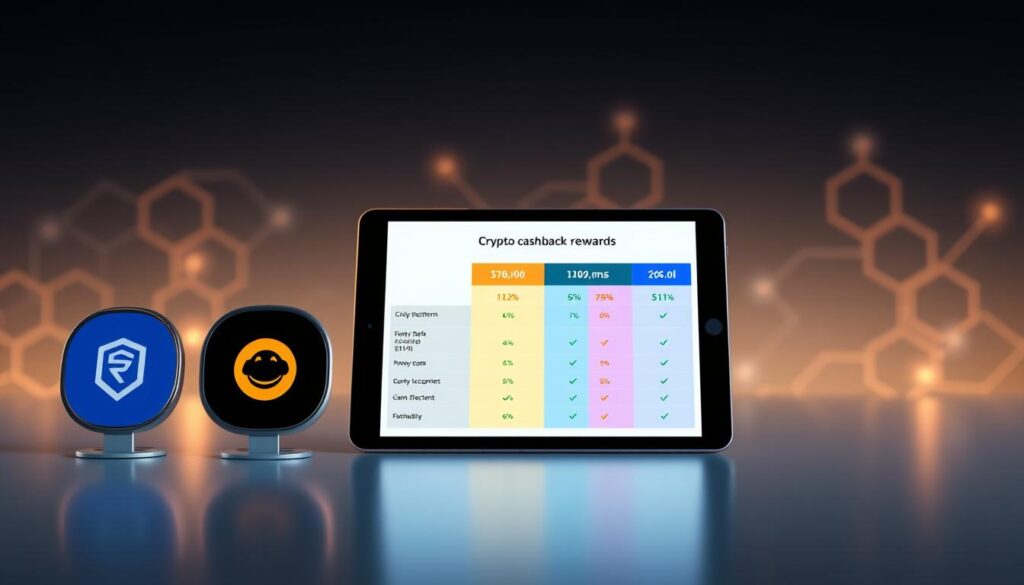Now Reading: Cryptocurrency Mining: Discover the Best Methods for You
- 01
Cryptocurrency Mining: Discover the Best Methods for You
Cryptocurrency Mining: Discover the Best Methods for You
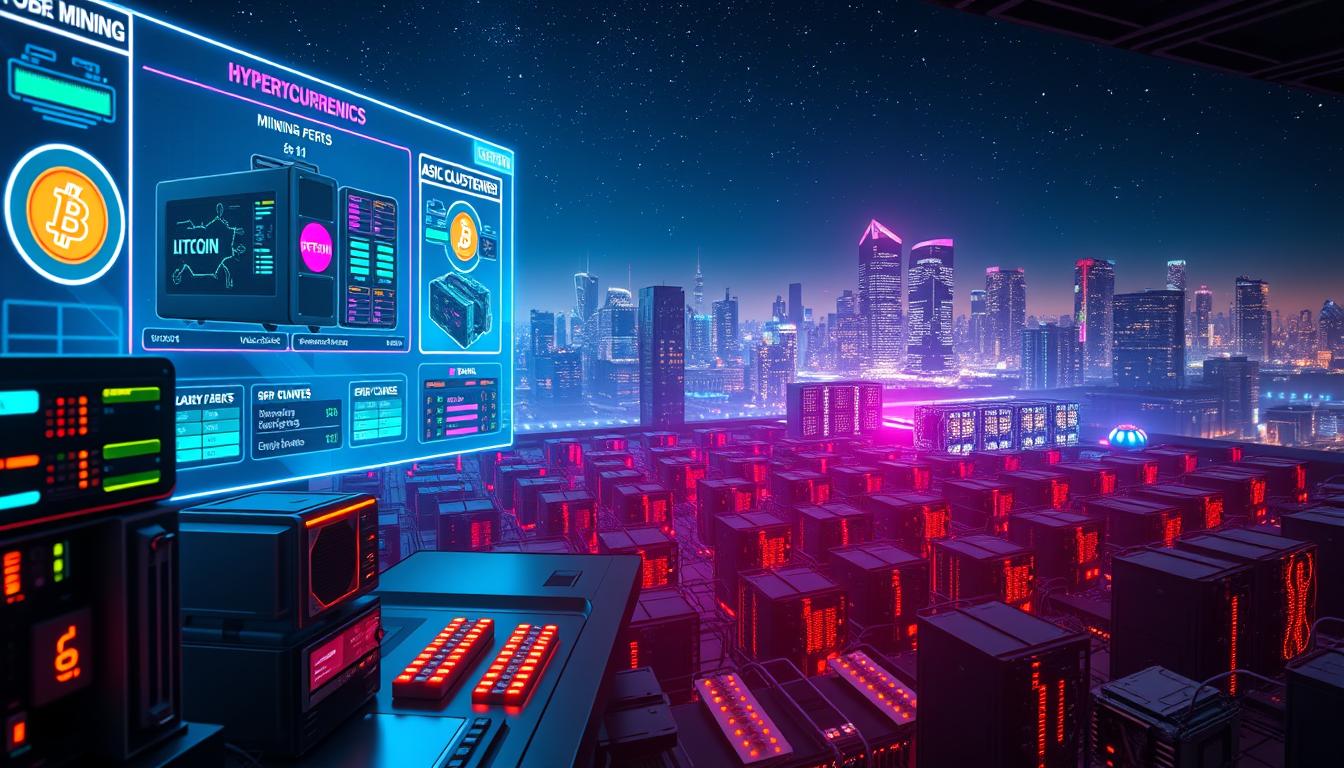
Choosing the right way to mine cryptocurrency can make technical issues profitable. This guide explains mining methods like ASIC, GPU, and cloud mining. It shows how to mine safely and efficiently.
Whether you’re setting up at home or joining a pool, we’ve got you covered. We talk about the hardware, costs, and energy use in 2023.
Key Takeaways
- Explore cryptocurrency mining options from solo setups to professional mining farms.
- Learn how to mine cryptocurrency using affordable hardware or cloud-based services.
- Discover profitability factors like hash rate, electricity costs, and blockchain rewards.
- Compare GPU mining vs. ASIC mining for popular coins like Bitcoin and Ethereum.
- Understand environmental impacts and energy-efficient mining strategies.
Understanding Cryptocurrency Mining
Cryptocurrency mining is key to blockchain networks. It helps create new coins and keeps transactions safe. For newbies, the beginner’s guide to mining crypto begins here. It involves powerful computers solving puzzles to validate transactions, earning rewards in cryptocurrency. Let’s dive into the basics and how tech has changed this digital world.
What Is Cryptocurrency Mining?
At its heart, mining is a race to solve math puzzles. Here’s the breakdown:
- Miners compete to solve puzzles using special hardware.
- The first to solve adds a block to the blockchain.
- Rewards include transaction fees and new coins.
How Mining Secures Blockchain Networks
Every transaction on the blockchain needs verification. Miners keep how to mine cryptocurrency safe by:
- Stopping double-spending by confirming each transaction.
- Creating a decentralized ledger without a central authority.
- Requiring agreement from network participants to change data.
The Evolution of Mining Technologies
Early miners used regular computers, but competition pushed for better tech in cryptocurrency mining options:
- CPUs (2009–2012): Standard processors started Bitcoin mining.
- GPUs (2013–2017):
- ASICs (2013–Present): Specialized devices like Bitmain’s Antminer lead Bitcoin mining.
NVIDIA and AMD graphics cards took over.
These changes show how tech progress makes mining more accessible and efficient.
Why People Choose to Mine Cryptocurrencies
Mining cryptocurrencies is more than just setting up tech—it’s about personal goals. Many aim to make money from their hardware investments. They look for profitable mining strategies to earn a steady income.
Block rewards and transaction fees are key sources of income. This is especially true for top mining cryptocurrencies like Bitcoin or Ethereum. These coins have strong market values.
Some mine to avoid exchange fees or privacy issues. Mining lets them access crypto directly, without third-party involvement. Many also support blockchain’s decentralized idea by securing networks with their computing power.
Learning is another reason people mine. Setting up rigs and learning software teaches them about blockchain, cryptography, and optimizing hardware. But, it’s important to be realistic.
Competition and energy costs are rising. Tools like profitability calculators help miners see if their efforts match their goals. Success depends on keeping up with market changes.
Whether for money, privacy, ideals, or knowledge, mining offers many paths. But, it’s crucial to research and match strategies with real-world conditions.
Cryptocurrency Mining Options in 2023
Choosing the right way to mine cryptocurrency depends on your resources and goals. You might want flexibility, low costs, or to mine a lot. This guide will help you understand the different methods, from using your own hardware to cloud mining services.
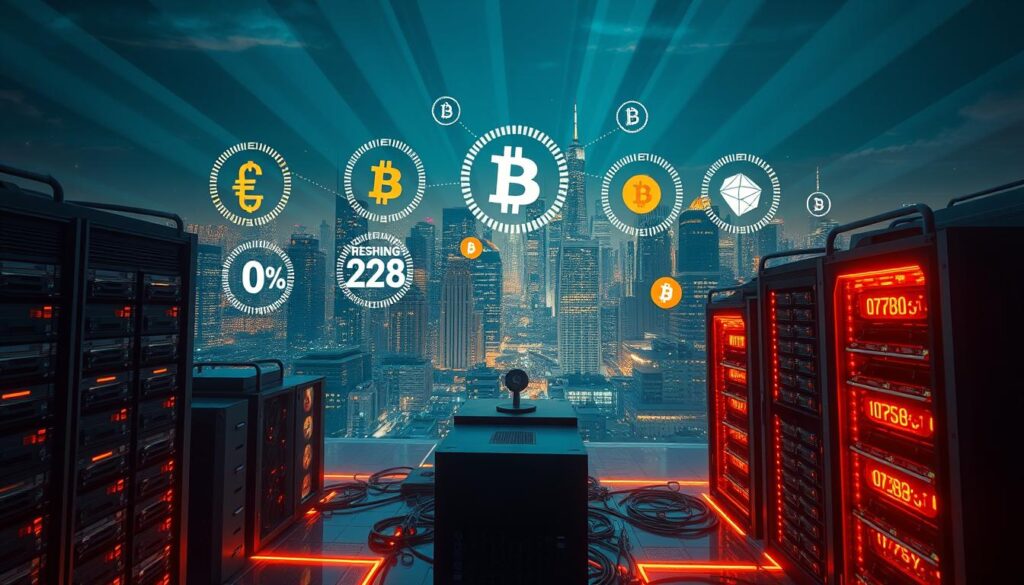
Solo Mining vs. Pool Mining
Solo mining means working alone to find blocks and getting the whole reward if you succeed. Pool mining lets you join others to share the work and rewards, but you get a smaller share. Solo mining is for those who want big rewards but are okay with taking big risks. Pool mining is better for steady, smaller rewards.
ASIC Mining
ASIC miners are made for specific tasks, like Bitcoin mining. They are very good at it but can’t change what they do. Once you use them, you can’t easily switch to mining other coins.
GPU Mining
Graphics cards can mine many different coins, including Ethereum. They’re not as good as ASICs but are more flexible. This makes them a good choice if you want to mine different coins without spending too much.
CPU Mining
CPUs are not as good as special mining hardware for most coins. But, they’re good for coins that value privacy, like Monero. They’re cheap to start but don’t make much money.
Cloud Mining
Cloud mining lets you mine without your own hardware. You pay for someone else’s mining power. It’s easy to start but you might not know how much energy it uses or who you’re paying.
Proof-of-Work vs. Proof-of-Stake Mining
Two main systems power cryptocurrency networks: Proof-of-Work (PoW) and Proof-of-Stake (PoS). Each affects how miners help keep blockchain safe. Knowing the differences is crucial for picking the best cryptocurrency mining options.
Understanding Proof-of-Work Mechanisms
PoW needs miners to solve tough math puzzles with special hardware. Bitcoin and Ethereum (before 2022) used this method. Miners race to check transactions, earning rewards for solving blocks first. But, this how to mine cryptocurrency way requires expensive GPUs or ASICs, raising costs.
The Shift Toward Proof-of-Stake
Ethereum switched to PoS in 2022, a big change. PoS validators are picked based on how many coins they hold (“staking”) instead of how fast they can solve puzzles. This cuts energy use by 99.9% while keeping things secure. For miners, this change opens up new staking chances that need less tech.
Energy Consumption Differences
- PoW: Uses a lot of energy to solve puzzles (e.g., Bitcoin uses ~150 TWh/year)
- PoS: Uses tokens for validation, cutting energy use by 99.9% compared to PoW
Miners looking at cryptocurrency mining options must think about these trade-offs. PoW is still key for old coins, while PoS is greener, like Cardano and Solana. Pick based on your budget, green goals, and what coins you want to mine.
Essential Hardware for Cryptocurrency Mining
Choosing the right crypto mining hardware is key to making money. Modern setups need parts that work well with certain algorithms and use less energy. This section talks about important gear and best cryptocurrency mining methods for better efficiency.
Top Mining GPUs in 2023
NVIDIA and AMD GPUs are leaders in GPU mining. The top models are the NVIDIA RTX 4080 and AMD Radeon RX 7900 XTX. These GPUs offer good hash rates and use less energy, perfect for mining altcoins like Ethereum. Make sure to check their efficiency to match your best cryptocurrency mining methods.
ASIC Miners: Pros and Cons
- Pros: High hash rates for Bitcoin and SHA-256 algorithms
- Cons: Single-algorithm use, high upfront costs
Brands like Bitmain’s Antminer S19 Pro are top for Bitcoin mining but limit you to specific coins.
Power Supply Considerations
PSUs must match the power needs of your rig. Calculate the total wattage of your GPUs/ASICs and add 20% for extra power. Choose 80+ Platinum-rated units for better energy efficiency. Tools like mining software can help estimate power needs before buying.
Cooling Solutions for Mining Rigs
Keeping your rig cool is crucial for its longevity. You can use:
- Air cooling with custom fans
- Custom liquid cooling loops
- Immersion cooling for extreme setups
Good cooling, along with efficientcrypto mining hardware, cuts down on downtime and costs.
Mining Software You Need to Know
Effective cryptocurrency mining software is key to any mining setup. It doesn’t matter if you use ASICs or GPUs. The right tools make operations smoother and increase earnings. Here’s how to pick and use the top options.
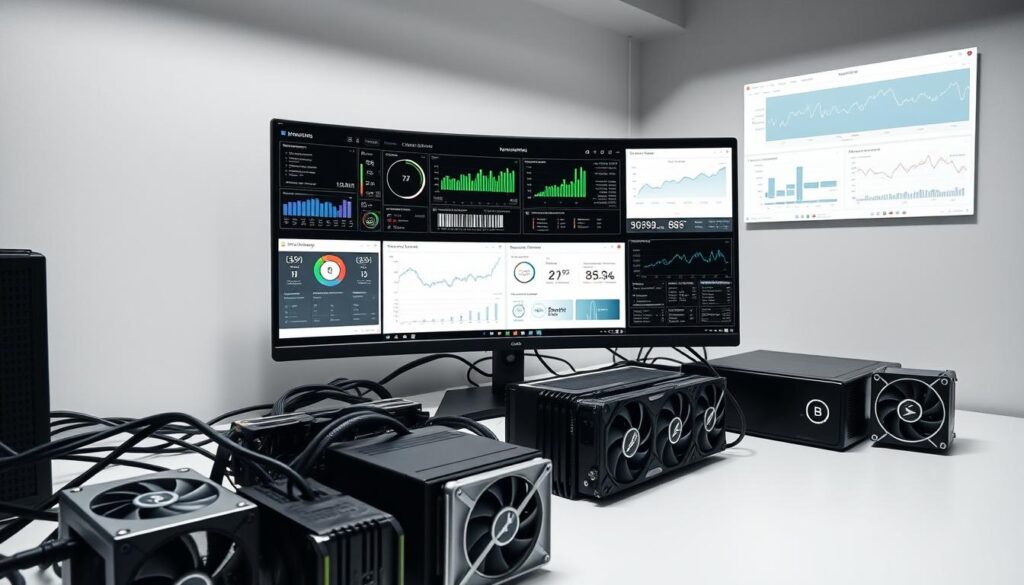
- NiceHash: Connects miners to global pools instantly, handling payments and algorithm switches automatically.
- CGMiner: A versatile open-source tool supporting SHA-256 and Scrypt algorithms, ideal for Bitcoin and Litecoin.
- T-Rex Miner: Specializes in Equihash algorithms for Zcash and Horizen, optimizing ASIC performance.
Operating systems like HiveOS and Minerstat make remote management easy. They track real-time metrics like hash rates and power usage. Tools like Minerstat or CGMiner’s API warn of hardware problems before they cause downtime. Wallet software, such as Electrum or Trust Wallet, keeps mined coins safe. Configuration utilities like MSI Afterburner help tweak GPU settings for the best performance.
Choosing the right how to mine cryptocurrency software depends on your hardware and goals. Use tools like WhatToMine to check profitability before setting up. Keep software up to date for the latest features and security.
Setting Up Your Mining Operation
Starting a crypto mining operation needs careful planning. This guide helps you choose the right location, power, and setup. It ensures your mining hardware works well and stays safe.
Location and Space Requirements
Find a spot with good air flow and no flammable stuff. A garage or a room is good for small setups. Big operations need industrial spaces with special floors for air.
Keep rigs 6-12 inches apart to avoid overheating.
Electrical Setup and Safety
First, figure out how much power your mining gear needs. Then, get a special circuit for it. Important safety steps include:
- UL-listed surge protectors
- Fire-resistant wiring
- Smoke detectors near equipment
Don’t use extension cords for long-term setups.
Internet Requirements
You need fast internet, at least 100 Mbps, for mining pools. Use Ethernet cables instead of Wi-Fi. Have a backup modem/router ready for when the internet goes down. Some mining software needs a public IP address.
Creating a Mining Farm
To grow, you need the right zoning and cooling systems. Watch local energy costs and rules. Use rackmounts to organize ASIC miners. Keep your gear updated to protect against hackers.
Cloud Mining Services for Beginners
Cloud mining services are a great beginner’s guide to mining crypto. They don’t need technical skills or expensive hardware. This makes it easy for new users to get into cryptocurrency mining options.
Users can invest in processing power in remote data centers. This means no need to worry about managing equipment or electricity costs.
- Access mining power via subscription plans
- No need to install or cool hardware
- Providers like Genesis Mining and Hashflare offer transparent contracts
However, there are risks like hidden fees and contract terms that lock funds during price drops. Always check reviews and avoid platforms promising unrealistic returns. Make sure hash rate allocations match what’s advertised.
Beginners should start with low-cost contracts to test provider reliability. Compare fee structures and supported coins like Bitcoin or Ethereum. Use live profit calculators to estimate earnings accurately.
Choose services with public facility locations and third-party audits. Avoid commitments over six months to stay flexible. Focus on clarity over short-term gains for long-term success.
Mining Bitcoin: Requirements and Strategies
Bitcoin mining needs special crypto mining hardware and smart planning. Unlike top mining cryptocurrencies that can be mined with GPUs, Bitcoin uses ASICs for its SHA-256 algorithm. Here’s how to do it well.
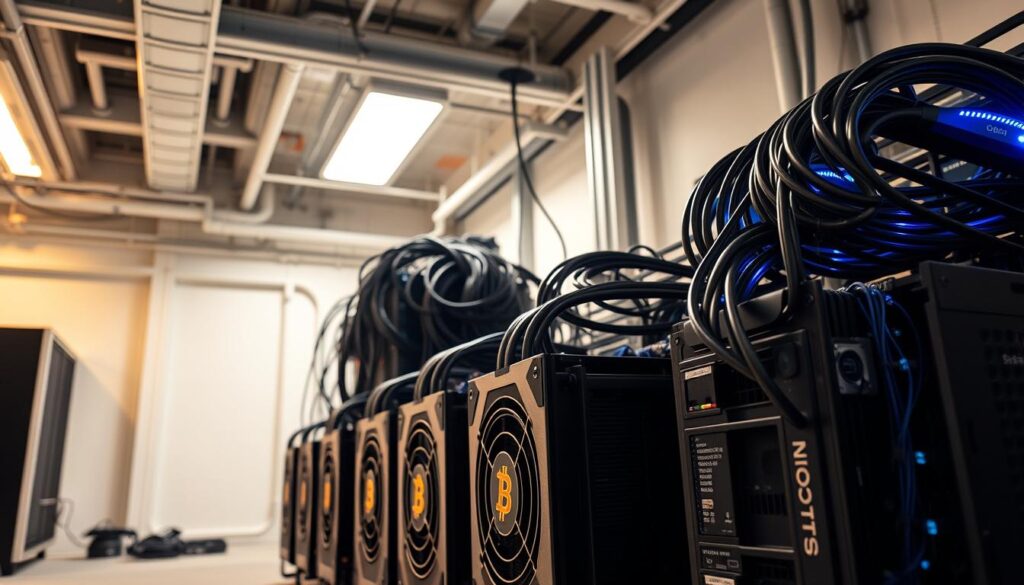
- Bitmain Antminer S19 series (110 TH/s, 3250W)
- MicroBT Whatsminer M30S (110 TH/s, 3085W)
- Canaan Avalon A1246 (98 TH/s, 2750W)
Hash rate depends on the hardware you choose. For instance:
- The Antminer S19 XP gets ~110 TH/s with low power use.
- Lower-end models like Avalon A1246 save costs but earn less.
Joining profitable mining strategies like pools boosts earnings. Popular choices include:
- F2Pool (0.5% fee, instant payouts)
- Antpool (0.9% fee, great for beginners)
- Foundry USA (supports merged mining)
Calculating profitability timelines is key. Consider:
- Hardware costs (e.g., $10k per Antminer S19)
- Electricity rates ($0.05/kWh or lower is best)
- Difficulty adjustments every 2016 blocks
Individual miners face big challenges as big players lead. Even with the best crypto mining hardware, it may take 12–18 months to break even. Keep an eye on Bitcoin price trends and hardware updates to improve profitable mining strategies.
Ethereum Mining Made Simple
After Ethereum moved to Proof-of-Stake in September 2022, old mining ways no longer work. Miners need new strategies to keep making money.
- Ethereum Classic (ETC): This PoW-based coin uses the same algorithm as old ETH. It’s a good cryptocurrency mining options for those with old GPUs.
- GPU-Friendly Coins: Monero (XMR) and Litecoin (LTC) are great for high-hashrate GPUs. Use tools like WhatToMine to see if they’re profitable.
- Ethereum Staking: Use your hardware for ETH staking. It’s easy and doesn’t use a lot of energy. You need 32 ETH, though.
Look for coins with low network difficulty and strong demand. Ethash, used by ETC, is better for old hardware. Keep an eye on Ethereum PoW (ETHW) for possible chances, but its future is unsure.
Being flexible is important. Keep your mining software up to date and watch coin prices. For many, using GPUs for Litecoin or staking is safer than betting on new forks.
Alternative Cryptocurrencies Worth Mining
Looking into top mining cryptocurrencies other than Bitcoin and Ethereum can lead to new opportunities. Litecoin, Monero, and Ravencoin offer unique chances with specific hardware and algorithms. These options fit well with
Litecoin Mining
Litecoin uses the Scrypt algorithm, which is best for ASIC miners. Its steady market makes it a solid choice. For the best results, use ASICs like the Antminer L3++.
Joining pools like LitecoinPool.org can also boost your rewards.
Monero Mining
Monero’s RandomX algorithm is great for CPUs, so you don’t need special hardware. It’s good for those who value privacy. Use XMRig software and pools like MoneroOcean to earn more.
Ravencoin Mining
Ravencoin’s X16R algorithm is designed to avoid ASIC dominance, making it better for GPUs. NVIDIA or AMD GPUs work well with RVN Miner. Keep an eye on its market to find the best times to mine.
Emerging Altcoins
New coins like Horizen and Verus Coin use algorithms that resist ASICs. Use profitability calculators to check their potential. Choose coins with active development and strong communities to lower risks.
To succeed, match your hardware to the coin’s algorithm. Keep up with profitable mining strategies on platforms like CoinLedger. This balance helps you make money in a competitive field.
Calculating Mining Profitability
Getting into profitable mining strategies means doing the math right. Tools like Minerstat’s calculator make it easier. They consider your hardware, electricity costs, and current coin prices. These tools show you when you’ll break even and when you’ll start making money.
- Cost factors: Hardware costs, electricity rates, cooling, and maintenance fees.
- Revenue variables: Block rewards, transaction fees, and cryptocurrency price swings.
Cryptocurrency mining options differ a lot. ASIC miners are great for Bitcoin, while GPUs work well for Ethash. To make more money, watch your electricity costs and switch coins on platforms like WhatToMine or NiceHash. Also, think about using heat recapture systems or selling your coins when prices are high.
Always check if your best cryptocurrency mining methods are still working. Changes in difficulty and prices can affect your earnings. Don’t ignore these changes or you might lose money. Use clear tools and stay flexible to succeed in this fast-changing world.
Environmental Considerations of Crypto Mining
Cryptocurrency mining’s energy needs have led to big environmental debates. As mining grows, so does the need to balance profits with protecting the planet. This section looks at energy use, eco-friendly changes, and policy shifts that will shape mining’s future.
Energy Consumption Facts
Bitcoin mining alone uses about 150 terawatt-hours of energy each year. That’s more than Argentina uses in total. It also accounts for 0.6% of global electricity, more than traditional banking’s 0.5%. Key stats:
- Bitcoin’s annual energy use rivals Norway’s national consumption.
- Proof-of-work systems account for 90% of crypto’s energy footprint.
Green Mining Initiatives
Miners are turning to renewables to reduce emissions. In Iceland, 80% of mining is powered by geothermal plants. Companies like Marathon Digital use solar in Texas, and Hydro Miners in Canada rely on hydropower. Upgrading to efficient crypto mining hardware like Antminer S19 Pro models cuts power use by 30%. Innovations include:
- Stranded gas capture in oil fields to fuel rigs.
- Grid partnerships to mine during off-peak hours.
Regulatory Challenges
China banned mining in 2021, moving 90% of operations. New York’s 2023 moratorium on new projects shows stricter rules are coming. Federal proposals might tax carbon-intensive cryptocurrency mining options, increasing costs for non-compliant setups. Miners now consider regulatory risks when calculating profits.
Security Best Practices for Miners
Protecting your mining operation starts with strong security measures. The beginner’s guide to mining crypto shows how to avoid threats. Every layer, from hardware to software, must be secure.
Physical security starts with locked facilities and cameras. Keep mining gear in safe areas with fire systems. Insure your hardware against theft or damage.
- Use cryptocurrency mining software from official sources only
- Verify software downloads with checksums to avoid malware
- Isolate mining networks from personal devices
Network safety needs firewalls and encrypted connections. Use strong, unique passwords for mining pools and enable two-factor authentication. Update your router firmware often to block unauthorized access.
Store mined crypto in hardware wallets for long-term. Move funds to cold storage offline. For active mining, use multi-signature wallets needing multiple approvals for transfers.
Check mining dashboards daily for unusual activity. Regularly scan devices for malware and avoid sharing pool credentials. Always update software to patch security gaps.
The Future of Cryptocurrency Mining
New technologies are changing how we mine cryptocurrencies. Energy-saving ASICs and AI cooling systems are leading the charge. Liquid cooling and modular rigs aim to cut costs and boost efficiency.
Companies like Bitmain and Canaan are making hardware that uses 30% less power. Cloud platforms are also making mining more accessible for smaller operators.
The 2024 halving event for Bitcoin will test miners’ profits. Miners will look for coins with better reward structures. Coins like Ethereum Classic and Monero, resistant to ASICs, might become more popular.
Regulatory changes in the U.S. are pushing for renewable energy in mining. Companies like Tesla are exploring solar-powered mining farms to meet new standards.
Profitable mining will need tech upgrades and policy changes. Home mining appliances could attract new users. Large farms will use AI for better returns.
Even as Ethereum moves to Proof-of-Stake, coins like Bitcoin Gold and Zcash might find their niche. Miners need to watch energy markets and coin economics closely.
The future of mining depends on its ability to adapt. Whether through decentralized pools or green energy initiatives, innovation and flexibility are key. Those who use the latest tech and strategies will overcome challenges and thrive.
FAQ
What are the different cryptocurrency mining options available?
You can mine cryptocurrencies in several ways. These include solo mining, pool mining, and using ASICs, GPUs, or CPUs. Cloud mining is also an option. Each method has its own benefits and fits different needs and skills.
How do I start mining cryptocurrency as a beginner?
First, pick a mining method that fits your skills and budget. You’ll need the right hardware, like ASICs or GPUs. Then, set up your mining software and join a mining pool or mine solo.
Make sure your internet is stable. Also, think about power use and cooling your equipment.
Which cryptocurrencies are considered the best for mining in 2023?
In 2023, top mining cryptocurrencies include Bitcoin and Ethereum Classic. Litecoin, Monero, and Ravencoin are also good choices. New altcoins might also be profitable due to less competition.
What is the difference between Proof-of-Work and Proof-of-Stake mining?
Proof-of-Work (PoW) mining solves complex math problems to validate transactions. It needs lots of energy and computing power. Proof-of-Stake (PoS) mining uses the amount of cryptocurrency you hold to validate transactions. It uses less energy and has different profit dynamics.
How can cloud mining services benefit beginners?
Cloud mining lets beginners rent mining power without needing hardware. It’s cheaper and easier to start. But, pick reliable providers and understand the risks.
What are the key factors to calculate mining profitability?
To figure out mining profits, consider costs like hardware, electricity, and maintenance. Also, look at potential earnings from block rewards and transaction fees. Don’t forget to check the cryptocurrency’s market price.
What hardware is recommended for effective cryptocurrency mining?
For mining, use top GPUs for general mining, ASIC miners for specific algorithms, and good power supplies. Don’t forget cooling solutions to handle heat. Choose hardware that matches your mining goals.
How can I ensure the security of my mining operation?
For security, protect your mining gear physically and keep your network safe with VPNs and firewalls. Use strong passwords and hardware wallets for storing mined coins. Always update your mining software to avoid security issues.
Are there any environmental considerations in cryptocurrency mining?
Yes, mining uses a lot of energy. But, there are green mining options that use renewable energy. Miners should aim to be sustainable and follow energy use regulations.




